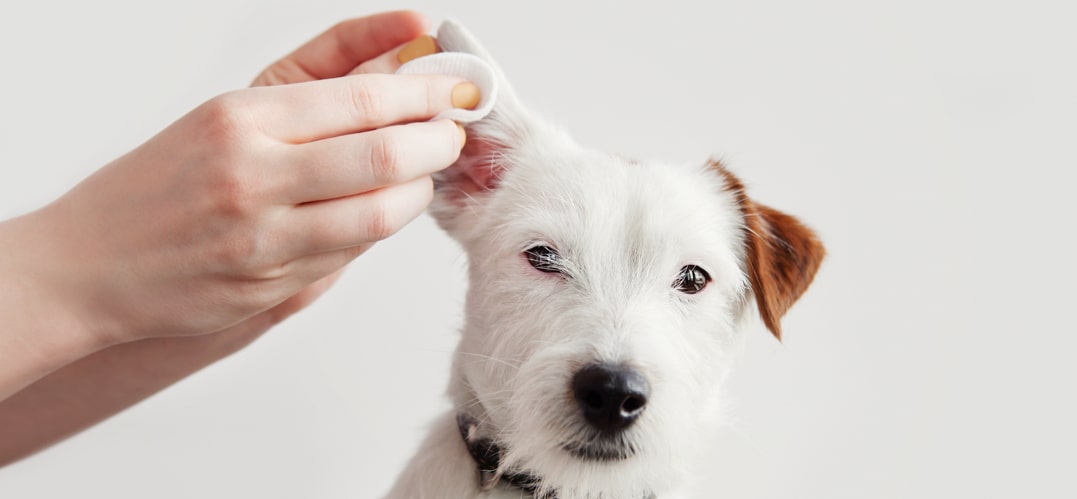Cleaning your dog ears is essential to help prevent a range of potential issues, from painful infections to impaired hearing. In this comprehensive guide, we'll walk you through the process of cleaning your dog's ears.
Understanding Canine Ear Anatomy
Before we dive into the cleaning process, let's first familiarise ourselves with the unique structure of a dog's ear. A dog's ear comprises three main components: the outer ear (pinna), the middle ear, and the inner ear. The pinna, or visible part of the ear, collects sound waves and directs them towards the ear canal. The middle and inner ear, nestled deeper within the head, are crucial for auditory processing. Dogs have a horizontal ear canal, which makes them prone to ear problems if not properly cared for.
Recognising Signs of Ear Problems
It's vital to be aware of the signs that may indicate a problem with your dog's ears. A distinct, unpleasant odour emanating from the ears could be indicative of an infection or wax buildup. Persistent scratching or pawing at the ears may signal discomfort or irritation. Redness, swelling, or inflammation within the ear canal should not be ignored, as these are clear signs of an issue. Unusual discharge, whether pus-like or tinged with blood, requires immediate attention. Keep a close eye on changes in your dog's behaviour, such as increased irritability or signs of pain, as these could be linked to ear problems.
Gathering the Necessary Supplies
To clean your dog's ears effectively, it's imperative to have the right tools at hand. You will need cotton balls or pads to gently wipe away debris, a veterinarian-approved ear cleaning solution designed specifically for dogs, towels or tissues for cleanup, and treats to offer positive reinforcement during and after the process.
Preparing Your Dog for Ear Cleaning
Creating a calm and comfortable environment is key to a successful ear cleaning session. Choose a quiet, well-lit space where you and your dog can both relax. Begin by soothing your dog with gentle strokes and reassuring words to establish trust. A reward-based approach can be highly effective – offer treats before, during, and after the process to create positive associations with ear cleaning.
The Step-by-Step Cleaning Process
Examine the Ears: Start by visually inspecting the outer ear for any signs of redness, swelling, or discharge. Gently palpate the area to check for tenderness or discomfort.
Apply Ear Cleaning Solution: Using a veterinarian-approved ear cleaning solution, saturate a cotton ball or pad. Gently insert it into the ear canal, being careful not to push too deep. Gently massage the base of the ear for about 30 seconds to allow the solution to break up any debris or wax.
Wipe Away Debris: With a fresh cotton ball or pad, carefully wipe away any loosened debris from the ear canal and outer ear. Take care not to use excessive force, as this can cause further irritation.
Repeat if Necessary: If the ears are particularly dirty, repeat the process using a fresh cotton ball and more cleaning solution.
Frequency of Ear Cleaning
Ear cleaning is a crucial aspect of maintaining your dog's overall health. The frequency of ear cleaning largely depends on factors such as breed, activity level, and individual predispositions. Here are some guidelines to help you determine how often to clean your dog's ears:
1. Breed Considerations
- Floppy-Eared Breeds: Dogs with floppy ears, like Basset Hounds or Cocker Spaniels, are more prone to ear issues due to reduced airflow. They may require more frequent cleaning, typically once a week.
- Prick-Eared Breeds: Breeds with erect ears, such as German Shepherds or Jack Russell Terriers, tend to have fewer problems. Cleaning every 2-4 weeks may suffice, but always monitor for any signs of discomfort or discharge.
- Hairy-Eared Breeds: Breeds with long, dense fur around the ears, like Poodles or Shih Tzus, may accumulate more debris. These dogs may benefit from more frequent cleaning, around every 2-3 weeks.
2. Activity Levels
Highly Active Dogs: Dogs engaged in activities like swimming, hiking, or regular outdoor play may require more frequent ear cleaning, as moisture and foreign particles can get trapped. Cleaning after each activity or at least every two weeks is advisable.
Less Active Dogs: Dogs with a more sedentary lifestyle may not need as frequent cleaning. A monthly ear check and cleaning should suffice, but be attentive to any signs of discomfort.
3. Individual Predispositions
Previous Ear Issues: Dogs with a history of ear infections or recurring problems may require more frequent cleaning. Follow your veterinarian's recommendations for these cases.
Allergies or Sensitivities: Dogs with allergies may be more prone to ear issues. Regular cleaning can help manage these conditions. Consult your vet for a personalized schedule.
Tips for Maintaining Ear Health Beyond Cleaning
1. Regular Check-ups with the Veterinarian
Regular veterinary check-ups are crucial for monitoring your dog's overall health, including their ears. During these visits, your vet will inspect your dog's ears for any signs of infection, inflammation, or abnormalities. Early detection can prevent more serious issues from developing.
2. Proper Grooming Techniques
In addition to cleaning, proper grooming practices play a significant role in ear health. This includes:
- Trimming Excess Hair: For dogs with long or dense fur around the ears, regular trimming can help prevent debris buildup.
- Nail Trimming: Long nails can cause discomfort and even injury if your dog scratches their ears. Keep nails well-maintained.
- Bathing: Ensure that water doesn't enter the ears during baths. Use a cotton ball to gently plug the ear canal.
3. Dietary Considerations
A balanced diet contributes to overall health, including the health of your dog's ears. Omega-3 fatty acids, found in fish oil supplements or certain dog foods, can help reduce inflammation and promote healthy skin, which indirectly benefits the ears.
Consult your vet for specific dietary recommendations tailored to your dog's individual needs.
Conclusion
Regular ear cleaning is a fundamental aspect of responsible dog ownership, ensuring your beloved companion enjoys optimal ear health. By understanding the unique anatomy of a dog's ear, recognising signs of potential problems, and following a step-by-step cleaning process, you can safeguard your dog's auditory well-being. Remember, always consult your veterinarian if you have concerns about your dog's ear health or encounter any unusual symptoms. With proper dog care, you can keep your dog's ears clean, comfortable, and free from potential issues.
As a devoted dog owner, you understand the importance of regular grooming to keep your furry friend happy and healthy. One often overlooked aspect of canine care is ear hygiene.




